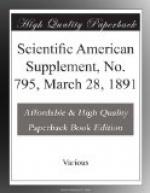Here is a tube (Fig. 15, P=0.00068 millimeter, or 0.9 M), with two negative electrodes, AA’, so placed as to protect two luminous spots on the phosphorescent glass of the tube. One electrode, A’, is of pure silver, a volatile metal; the other, A, is of aluminum, practically non-volatile. A quantity of “electrode matter” will be shot off from the silver pole, and practically none from the aluminum pole; but you see that in each case the phosphorescence, CC’, is identical. Had the radiant electrode matter been the active agent, the more intense phosphorescence would proceed from the more volatile pole.
A drawing of another experimental piece of apparatus is shown in Fig. 16. A pear-shaped bulb of German glass has near the small end an inner concave negative pole, A, of pure silver, so mounted that its inverted image is thrown upon the opposite end of the tube. In front of this pole is a screen of mica, C, having a small hole in the center, so that only a narrow pencil of rays from the silver pole can pass through, forming a bright spot, D, at the far end of the bulb. The exhaustion is about the same as in the previous tube, and the current has been allowed to pass continuously for many hours so as to drive off a certain portion of the silver electrode; and upon examination it is found that the silver has all been deposited in the immediate neighborhood of the pole; while the spot, D, at the far end of the tube, that has been continuously glowing with phosphorescent light, is practically free from silver.
[Illustration: FIG. 15.—PRESSURE = 0.00068 MM. = 0.9 M.]
The experiment is too lengthy for me to repeat it here, so I shall not attempt it; but I have on the table the results for examination.
The identity of action of silver and aluminum in the first case, and the non-projection of silver in this second instance, are in themselves sufficient to condemn Dr. Puluj’s hypotheses, since they prove that phosphorescence is independent of the material of the negative electrode. In front of me is a set of tubes that to my mind puts the matter wholly beyond doubt. The tubes contain no inside electrodes with the residual gaseous molecules; and with them I will proceed to give some of the most striking radiant-matter experiments without any inner metallic poles at all.
[Illustration: FIG. 16.—PRESSURE = 0.00068 MM. = 0.9 M.]
In all these tubes the electrodes, which are of silver, are on the outside, the current acting through the body of the glass. The first tube contains gas only slightly rarefied and at the stratification stage. It is simply a closed glass cylinder, with a coat of silver deposited outside at each end, and exhausted to a pressure of 2 millimeters. The outline of the tube is shown in Fig. 17. I pass a current, and, as you see, the stratifications, though faint, are perfectly formed.
[Illustration: FIG. 17.—PRESSURE = 2 MM.]




